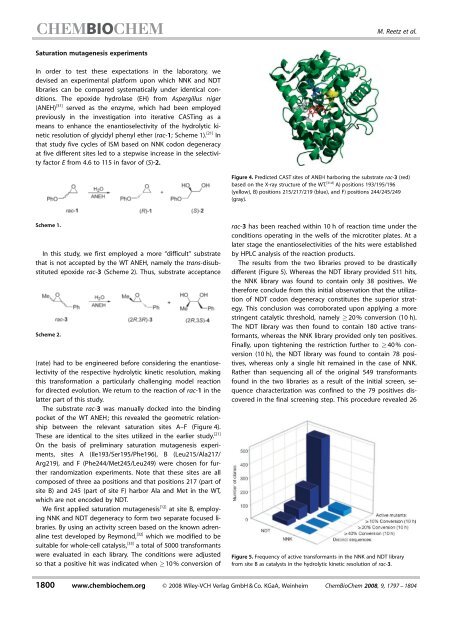Addressing the numbers problem in directed evolution.pdf
Addressing the numbers problem in directed evolution.pdf
Addressing the numbers problem in directed evolution.pdf
You also want an ePaper? Increase the reach of your titles
YUMPU automatically turns print PDFs into web optimized ePapers that Google loves.
Saturation mutagenesis experiments<br />
In order to test <strong>the</strong>se expectations <strong>in</strong> <strong>the</strong> laboratory, we<br />
ACHTUNGTRENUNGdevised an experimental platform upon which NNK and NDT<br />
ACHTUNGTRENUNGlibraries can be compared systematically under identical con-<br />
ACHTUNGTRENUNGditions. The epoxide hydrolase (EH) from Aspergillus niger<br />
(ANEH) [31] served as <strong>the</strong> enzyme, which had been employed<br />
previously<strong>in</strong> <strong>the</strong> <strong>in</strong>vestigation <strong>in</strong>to iterative CAST<strong>in</strong>g as a<br />
means to enhance <strong>the</strong> enantioselectivity of <strong>the</strong> hydrolytic k<strong>in</strong>etic<br />
resolution of glycidyl phenyl e<strong>the</strong>r (rac-1; Scheme 1). [21] In<br />
that studyfive cycles of ISM based on NNK codon degeneracy<br />
at five different sites led to a stepwise <strong>in</strong>crease <strong>in</strong> <strong>the</strong> selectivityfactor<br />
E from 4.6 to 115 <strong>in</strong> favor of (S)-2.<br />
Scheme 1.<br />
In this study, we first employed a more “difficult” substrate<br />
that is not accepted by<strong>the</strong> WT ANEH, namely<strong>the</strong> trans-disubstituted<br />
epoxide rac-3 (Scheme 2). Thus, substrate acceptance<br />
Scheme 2.<br />
(rate) had to be eng<strong>in</strong>eered before consider<strong>in</strong>g <strong>the</strong> enantioselectivity<br />
of <strong>the</strong> respective hydrolytic k<strong>in</strong>etic resolution, mak<strong>in</strong>g<br />
this transformation a particularlychalleng<strong>in</strong>g model reaction<br />
for <strong>directed</strong> <strong>evolution</strong>. We return to <strong>the</strong> reaction of rac-1 <strong>in</strong> <strong>the</strong><br />
latter part of this study.<br />
The substrate rac-3 was manuallydocked <strong>in</strong>to <strong>the</strong> b<strong>in</strong>d<strong>in</strong>g<br />
pocket of <strong>the</strong> WT ANEH; this revealed <strong>the</strong> geometric relationship<br />
between <strong>the</strong> relevant saturation sites A–F (Figure 4).<br />
These are identical to <strong>the</strong> sites utilized <strong>in</strong> <strong>the</strong> earlier study. [21]<br />
On <strong>the</strong> basis of prelim<strong>in</strong>arysaturation mutagenesis experiments,<br />
sites A (Ile193/Ser195/Phe196), B (Leu215/Ala217/<br />
Arg219), and F (Phe244/Met245/Leu249) were chosen for fur<strong>the</strong>r<br />
randomization experiments. Note that <strong>the</strong>se sites are all<br />
composed of three aa positions and that positions 217 (part of<br />
site B) and 245 (part of site F) harbor Ala and Met <strong>in</strong> <strong>the</strong> WT,<br />
which are not encoded byNDT.<br />
We first applied saturation mutagenesis [12] at site B, employ<strong>in</strong>g<br />
NNK and NDT degeneracyto form two separate focused libraries.<br />
Byus<strong>in</strong>g an activityscreen based on <strong>the</strong> known adrenal<strong>in</strong>e<br />
test developed byReymond, [32] which we modified to be<br />
suitable for whole-cell catalysis, [33] a total of 5000 transformants<br />
were evaluated <strong>in</strong> each library. The conditions were adjusted<br />
so that a positive hit was <strong>in</strong>dicated when 10% conversion of<br />
M. Reetz et al.<br />
Figure 4. Predicted CAST sites of ANEH harbor<strong>in</strong>g <strong>the</strong> substrate rac-3 (red)<br />
based on <strong>the</strong> X-raystructure of <strong>the</strong> WT. [31d] A) positions 193/195/196<br />
(yellow), B) positions 215/217/219 (blue), and F) positions 244/245/249<br />
(gray).<br />
rac-3 has been reached with<strong>in</strong> 10 h of reaction time under <strong>the</strong><br />
conditions operat<strong>in</strong>g <strong>in</strong> <strong>the</strong> wells of <strong>the</strong> microtiter plates. At a<br />
later stage <strong>the</strong> enantioselectivities of <strong>the</strong> hits were established<br />
byHPLC analysis of <strong>the</strong> reaction products.<br />
The results from <strong>the</strong> two libraries proved to be drastically<br />
different (Figure 5). Whereas <strong>the</strong> NDT libraryprovided 511 hits,<br />
<strong>the</strong> NNK librarywas found to conta<strong>in</strong> only38 positives. We<br />
<strong>the</strong>refore conclude from this <strong>in</strong>itial observation that <strong>the</strong> utilization<br />
of NDT codon degeneracyconstitutes <strong>the</strong> superior strategy.<br />
This conclusion was corroborated upon apply<strong>in</strong>g a more<br />
str<strong>in</strong>gent catalytic threshold, namely 20% conversion (10 h).<br />
The NDT librarywas <strong>the</strong>n found to conta<strong>in</strong> 180 active transformants,<br />
whereas <strong>the</strong> NNK libraryprovided onlyten positives.<br />
F<strong>in</strong>ally, upon tighten<strong>in</strong>g <strong>the</strong> restriction fur<strong>the</strong>r to 40% conversion<br />
(10 h), <strong>the</strong> NDT librarywas found to conta<strong>in</strong> 78 positives,<br />
whereas onlya s<strong>in</strong>gle hit rema<strong>in</strong>ed <strong>in</strong> <strong>the</strong> case of NNK.<br />
Ra<strong>the</strong>r than sequenc<strong>in</strong>g all of <strong>the</strong> orig<strong>in</strong>al 549 transformants<br />
found <strong>in</strong> <strong>the</strong> two libraries as a result of <strong>the</strong> <strong>in</strong>itial screen, sequence<br />
characterization was conf<strong>in</strong>ed to <strong>the</strong> 79 positives discovered<br />
<strong>in</strong> <strong>the</strong> f<strong>in</strong>al screen<strong>in</strong>g step. This procedure revealed 26<br />
Figure 5. Frequencyof active transformants <strong>in</strong> <strong>the</strong> NNK and NDT library<br />
from site B as catalysts <strong>in</strong> <strong>the</strong> hydrolytic k<strong>in</strong>etic resolution of rac-3.<br />
1800 www.chembiochem.org 2008 Wiley-VCH Verlag GmbH & Co. KGaA, We<strong>in</strong>heim ChemBioChem 2008, 9, 1797 – 1804













